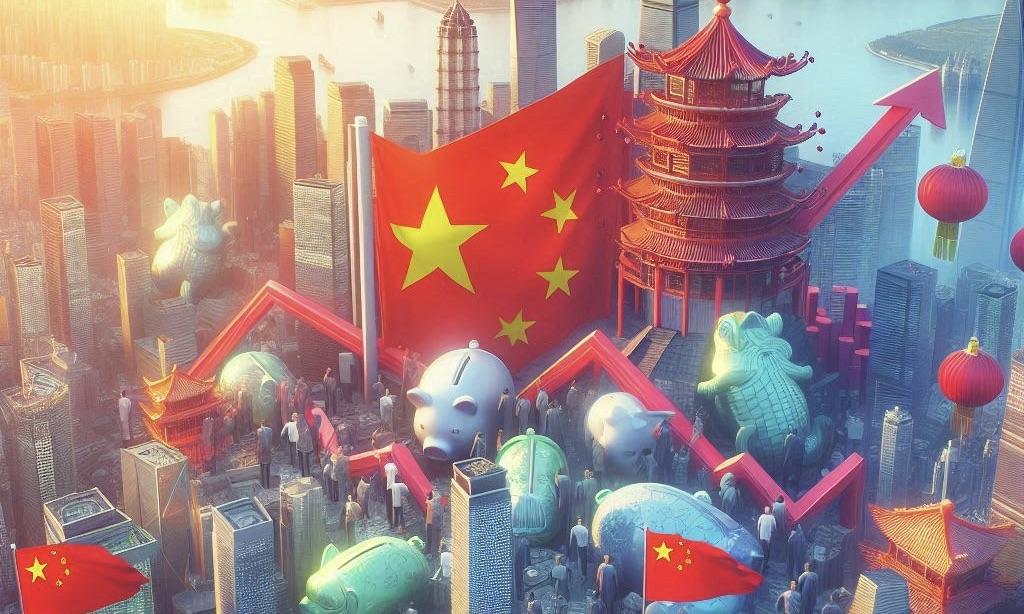On July 22, China, the world's second-largest economy, enacted unexpected interest rate cuts to stimulate its sluggish, debt-laden economy. The People's Bank of China lowered key rates by 10 basis points following disappointing second-quarter growth figures, signaling potential global economic repercussions.
China Cuts Key Interest Rates Following Disappointing Q2 Growth to Stimulate Economy
On July 22, China, the world's second-largest economy, implemented a series of interest rate cuts with potential global economic implications. These measures were aimed at bolstering its sluggish, debt-laden economy.
According to Business Insider, the People's Bank of China cut its seven-day reverse repo rate by 10 basis points, from 1.8% to 1.7%, and its standing lending facility — given to commercial banks to supply temporary cash — by the same margin.
China also cut its benchmark bank lending rates by 10 basis points, including its one-year loan prime rate and five-year LPR, which went from 3.45% to 3.35% and 3.95% to 3.85%, respectively.
The unexpected interest rate cuts were announced following the release of China's second-quarter economic data, which revealed a 4.7% growth rate, falling short of the 5.0% target and analysts' projections. This shortfall in growth underscored the need for the rate cuts.
China Balances Export-Driven Growth with Rate Cuts Amid Lagging Consumer Sentiment and Economic Tensions
China's strong exports drive its economic growth, even as consumer sentiment lags. Last month, household deposits hit record numbers, but retail sales expanded just 2% year over year in June.
The rate cuts follow a meeting of the country's leaders last week at the Communist Party's Central Committee, a plenum that occurs every five years.
"China's Third Plenum put 'high-quality development' as the top priority. Policy makers vowed to achieve 2024 growth target and manage risks of property, local govt debts, and smaller banks," Bank of America analysts wrote on July 22.
Other commentators noted that the reforms promised at the plenum and the rate cuts are positive developments but not enough to convince skittish investors that China's problems are behind it.
Despite the positive developments, such as the promised reforms and the interest rate cuts, there remains a noticeable tension in China's economic policies. This tension is evident in the conflicting goals of boosting economic security and expanding the economy's supply side versus giving market forces a greater role and rebalancing growth toward consumption.
China released a policy document following the meeting that outlines goals to improve business sentiment as the country's economy faces deflation, debt, a real estate crisis, and tense international trade relations with other large economies.



 European Oil & Gas Stocks Face 2026 With Cautious Outlook Amid Valuation Pressure
European Oil & Gas Stocks Face 2026 With Cautious Outlook Amid Valuation Pressure  Japan’s Nikkei Drops as Markets Await Key U.S. Inflation Data
Japan’s Nikkei Drops as Markets Await Key U.S. Inflation Data  European Stocks Rise as Markets Await Key U.S. Inflation Data
European Stocks Rise as Markets Await Key U.S. Inflation Data  China Urged to Prioritize Economy Over Territorial Ambitions, Says Taiwan’s President Lai
China Urged to Prioritize Economy Over Territorial Ambitions, Says Taiwan’s President Lai  Oil Prices Rise as Ukraine Targets Russian Energy Infrastructure
Oil Prices Rise as Ukraine Targets Russian Energy Infrastructure  Asian Currencies Edge Higher as Markets Look to Fed Rate Cut; Rupee Steadies Near Record Lows
Asian Currencies Edge Higher as Markets Look to Fed Rate Cut; Rupee Steadies Near Record Lows  Spain’s Industrial Output Records Steady Growth in October Amid Revised September Figures
Spain’s Industrial Output Records Steady Growth in October Amid Revised September Figures  Oil Prices Hold Steady as Ukraine Tensions and Fed Cut Expectations Support Market
Oil Prices Hold Steady as Ukraine Tensions and Fed Cut Expectations Support Market  Dollar Slides to Five-Week Low as Asian Stocks Struggle and Markets Bet on Fed Rate Cut
Dollar Slides to Five-Week Low as Asian Stocks Struggle and Markets Bet on Fed Rate Cut  Gold Prices Edge Higher as Markets Await Key U.S. PCE Inflation Data
Gold Prices Edge Higher as Markets Await Key U.S. PCE Inflation Data  Asian Currencies Steady as Markets Await Fed Rate Decision; Indian Rupee Hits New Record Low
Asian Currencies Steady as Markets Await Fed Rate Decision; Indian Rupee Hits New Record Low  IMF Deputy Dan Katz Visits China as Key Economic Review Nears
IMF Deputy Dan Katz Visits China as Key Economic Review Nears  Germany’s Economic Recovery Slows as Trade Tensions and Rising Costs Weigh on Growth
Germany’s Economic Recovery Slows as Trade Tensions and Rising Costs Weigh on Growth  Citi Sets Bullish 2026 Target for STOXX 600 as Fiscal Support and Monetary Easing Boost Outlook
Citi Sets Bullish 2026 Target for STOXX 600 as Fiscal Support and Monetary Easing Boost Outlook  Dollar Weakens Ahead of Expected Federal Reserve Rate Cut
Dollar Weakens Ahead of Expected Federal Reserve Rate Cut  Asia’s IPO Market Set for Strong Growth as China and India Drive Investor Diversification
Asia’s IPO Market Set for Strong Growth as China and India Drive Investor Diversification  Asian Markets Mixed as Fed Rate Cut Bets Grow and Japan’s Nikkei Leads Gains
Asian Markets Mixed as Fed Rate Cut Bets Grow and Japan’s Nikkei Leads Gains 































